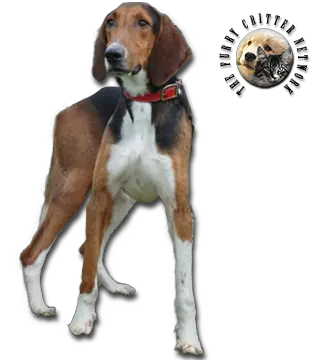Breed Standard
Head: Fairly large and long. Slightly domed skull. Slight stop (pronounced in the French Hound and the French White and Orange Hound). Nosebridge slightly curved. Flews covering the lower lip. Nose black or orangish-brown in the White and Orange.
Ears: Turning slightly, reaching almost to the base of the nose when outstretched.
Eyes: Dark
Body: Powerful. Neck fairly long and strong. Chest taller than it is wide. Slightly rounded ribs. Slight tuck-up.
Tail: Fairly thick at the base and fairly long, carried gracefully.
Hair: Lying close to the body, fairly thick, and dense. Finer in the Tricolor.
Coat:
- White and Black: must be white and black with a large mantle or fairly large black spots. Black, steel-grey, or even tan flecks only on the legs. Pale spot above each eye and pale tan markings on the cheeks, below the eyes, under the ears, and at the base of the tail. As in the Gascon Saintongeois, deer markings on the thigh are fairly common. Skin is white under white hair and black under black hair, sometimes with blue or pale blue blotches on the abdomen and inner thighs.- Tricolor: white and fawn (rich or even coppery tan) with black mantle. Wolf grey hair is tolerated.
- White and Orange: white and lemon or white and orange, as long as orange is not too dark or reddish. Skin white with yellow or orange spots.
Size: White and Black: dog: 65 to 72 cm( 25,5-28 in) ; bitch: 62 to 68 cm (24,5-26,8 in) .Tricolor: dog 62 to 72 cm (24,5-28 in); bitches 60 to 68 cm (23,5-26,8 in).Tricolor, White and Orange: 62 to 70 cm ( 24,5-27,5 in).
Weight: Approx. 30 kg (66 lb).
History
The French Hound, descended from ancient French breeds, comes in several varieties that differ in coat color:- The French White and Black Hound, descended from two breeds from southern France, the Saintongeois and the Blue Gascony Hound, with a splash of Foxhound blood. The variety was officially recognized in 1957;- The French Hound, a recent creation (1957) produced by crossing the Anglo-French Hound with the French Hound. Crosses were made with the Poitevin, the Billy, and possibly the Blue Gascony Hound. The French Hound is sturdier and not quite as fast as the Poitevin. The standard for this variety was officially recognized in 1965; and- The French White and Orange Hound, very rare, was developed in 1978 through crosses with the Billy.
Behavior
These dogs are hardy, brave, and able to maintain a swift pace for several hours. With a good voice and keen sense of smell, they hunt confidently in packs. Their work is meticulous. They specialize in deer. They require a firm owner they can accept as the leader of the pack.
Nothing should keep the French Hound from living with his owner. A kennel is recommended for more than one dog in the country. He needs regular brushing and attention to the ears.
Function
Hunting Dog, Companion Dog.
Health
Known as a very hearty breed. No breed specific issues found.






